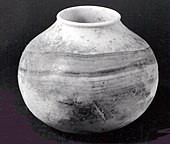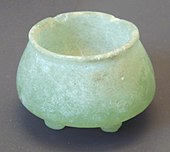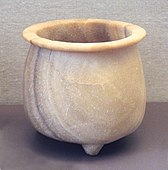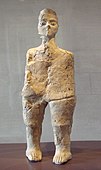Pre-Pottery Neolithic: Difference between revisions
पाटलिपुत्र (talk | contribs) also called |
पाटलिपुत्र (talk | contribs) text from "The Near-Eastern Roots of the Neolithic in South Asia" published under Creative Commons license CC BY 4.0 |
||
| Line 55: | Line 55: | ||
</gallery> |
</gallery> |
||
{{clear}} |
{{clear}} |
||
==Diffusion== |
|||
The spread of the [[Neolithic]] in Europe was first studied quantitatively in the 1970s, when a sufficient number of 14C age determinations for early Neolithic sites had become available. [[Ammerman]] and [[Cavalli-Sforza]] discovered a linear relationship between the age of an Early Neolithic site and its distance from the conventional source in the Near East ([[Jericho]]), thus demonstrating that, on average, the Neolithic spread at a constant speed of about 1 km/yr. More recent studies confirm these results and yield the speed of 0.6–1.3 km/yr at 95% confidence level.<ref>Original text published under Creative Commons license CC BY 4.0: {{cite book |last1=Shukurov |first1=Anvar |last2=Sarson |first2=Graeme R. |last3=Gangal |first3=Kavita |title=The Near-Eastern Roots of the Neolithic in South Asia |date=2014 |page=1 |url=https://journals.plos.org/plosone/article?id=10.1371/journal.pone.0095714 |language=en}}</ref> |
|||
==Relative chronology== |
==Relative chronology== |
||
Revision as of 15:46, 10 May 2019
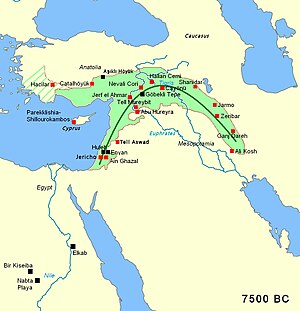 Area of the fertile crescent, circa 7500 BC, with main Pre-Pottery Neolithic sites. The area of Mesopotamia proper was not yet settled by humans. | |
| Geographical range | Fertile Crescent |
|---|---|
| Period | Neolithic |
| Dates | circa 8,500 B.C.E. — circa 5,500 B.C.E. |
| Type site | Jericho |
| Preceded by | Epipalaeolithic Near East (Kebaran culture, Natufian culture) |
| Followed by | Halaf culture, Neolithic Greece, Faiyum A culture |

The Pre-Pottery Neolithic (PPN, around 8500-5500 BCE)[2] represents the early Neolithic in the Levantine and upper Mesopotamian region of the Fertile Crescent. It succeeds the Natufian culture of the Epipalaeolithic Near East (also called Mesolithic), as the domestication of plants and animals was in its formative stages, having possibly been induced by the Younger Dryas. The Pre-Pottery Neolithic culture came to an end around the time of the 8.2 kiloyear event, a cool spell centred on 6200 BCE that lasted several hundred years. It is succeeded by the Pottery Neolithic.
Pre-Pottery Neolithic A
The Pre-Pottery Neolithic is divided into Pre-Pottery Neolithic A (PPNA 8500 BCE – 7600 BCE) and the following Pre-Pottery Neolithic B (PPNB 7600 BCE – 6000 BCE).[2] These were originally defined by Kathleen Kenyon in the type site of Jericho (Palestine). The Pre-Pottery Neolithic precedes the ceramic Neolithic (Yarmukian). At 'Ain Ghazal in Jordan the culture continued a few more centuries as the so-called Pre-Pottery Neolithic C culture.
Around 8000 BCE during the Pre-Pottery Neolithic A (PPNA) the world's first town Jericho appeared in the Levant.
-
Sculpture of a predatory animal, Göbekli Tepe, circa 9000 BC
-
Urfa Man, c. 9000 BC. Şanlıurfa Archaeology and Mosaic Museum.
Pre-Pottery Neolithic B
PPNB differed from PPNA in showing greater use of domesticated animals, a different set of tools, and new architectural styles.
-
Footed bowl in granite, Syria, end of 8th millennium BC.
-
Jar in calcite alabaster, Syria, late 8th millennium BC.
-
Green aragonite tripod vase Mid-Euphrates 6000 BCE Louvre Museum AO 28386
-
Calcite tripod vase, mid-Euphrates, probably from Tell Buqras, 6000 BC, Louvre Museum AO 31551
Pre-Pottery Neolithic C
Work at the site of 'Ain Ghazal in Jordan has indicated a later Pre-Pottery Neolithic C period. Juris Zarins has proposed that a Circum Arabian Nomadic Pastoral Complex developed in the period from the climatic crisis of 6200 BCE, partly as a result of an increasing emphasis in PPNB cultures upon domesticated animals, and a fusion with Harifian hunter gatherers in the Southern Levant, with affiliate connections with the cultures of Fayyum and the Eastern Desert of Egypt. Cultures practicing this lifestyle spread down the Red Sea shoreline and moved east from Syria into southern Iraq.[4]
-
'Ain Ghazal Statues: closeup of one of the bicephalous statues, c.7000 BC.
-
Ain Ghazal statue on show in the Musée du Louvre, Paris.
-
Louvre Ain Ghazal statue, frontal
Diffusion
The spread of the Neolithic in Europe was first studied quantitatively in the 1970s, when a sufficient number of 14C age determinations for early Neolithic sites had become available. Ammerman and Cavalli-Sforza discovered a linear relationship between the age of an Early Neolithic site and its distance from the conventional source in the Near East (Jericho), thus demonstrating that, on average, the Neolithic spread at a constant speed of about 1 km/yr. More recent studies confirm these results and yield the speed of 0.6–1.3 km/yr at 95% confidence level.[5]
Relative chronology
See also
| The Neolithic |
|---|
| ↑ Mesolithic |
| ↓ Chalcolithic |
References
- ^ Diamond, J.; Bellwood, P. (2003). "Farmers and Their Languages: The First Expansions". Science. 300 (5619): 597–603. Bibcode:2003Sci...300..597D. CiteSeerX 10.1.1.1013.4523. doi:10.1126/science.1078208. PMID 12714734.
- ^ a b Richard, Suzanne Near Eastern archaeology Eisenbrauns; illustrated edition (1 Aug 2004) ISBN 978-1-57506-083-5 p.244 [1]
- ^ Rice, Patricia C.; Moloney, Norah (2016). Biological Anthropology and Prehistory: Exploring Our Human Ancestry. Routledge. p. 636. ISBN 9781317349815.
- ^ Zarins, Juris (1992) "Pastoral Nomadism in Arabia: Ethnoarchaeology and the Archaeological Record," in Ofer Bar-Yosef and A. Khazanov, eds. "Pastoralism in the Levant"
- ^ Original text published under Creative Commons license CC BY 4.0: Shukurov, Anvar; Sarson, Graeme R.; Gangal, Kavita (2014). The Near-Eastern Roots of the Neolithic in South Asia. p. 1.
Further reading
- Ofer Bar-Yosef, The PPNA in the Levant – an overview. Paléorient 15/1, 1989, 57-63.
- J. Cauvin, Naissance des divinités, Naissance de l’agriculture. La révolution des symboles au Néolithique (CNRS 1994). Translation (T. Watkins) The birth of the gods and the origins of agriculture (Cambridge 2000).



![Ancestor Statue, Jericho, c. 9000 BC (Replica). Israel Museum.[3]](http://upload.wikimedia.org/wikipedia/commons/thumb/2/2f/Ancestor_Statue%2C_Jericho%2C_c._9000_BC%2C_Replica.jpg/105px-Ancestor_Statue%2C_Jericho%2C_c._9000_BC%2C_Replica.jpg)

